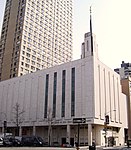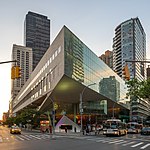66th Street station (IRT Ninth Avenue Line)
66th Street was an express station on the demolished IRT Ninth Avenue Line in Manhattan, New York City. It had two levels. The lower level was built first and had two tracks and two side platforms. The upper level was built as part of the Dual Contracts and had two track and two side platforms over the lower level local tracks. The station closed on June 11, 1940. The next southbound local stop was 59th Street. The next southbound express stop was 34th Street for Ninth Avenue trains, and 50th Street for IRT Sixth Avenue Line express trains. The next northbound local stop was 72nd Street. The next northbound express stop was 116th Street. The express run from this stop to 116th Street was the longest express segment out of all New York City elevated lines, bypassing seven local stations.
Excerpt from the Wikipedia article 66th Street station (IRT Ninth Avenue Line) (License: CC BY-SA 3.0, Authors).66th Street station (IRT Ninth Avenue Line)
Columbus Avenue, New York Manhattan
Geographical coordinates (GPS) Address Nearby Places Show on map
Geographical coordinates (GPS)
| Latitude | Longitude |
|---|---|
| N 40.7736 ° | E -73.981586111111 ° |
Address
Columbus Avenue
Columbus Avenue
10025 New York, Manhattan
New York, United States
Open on Google Maps








